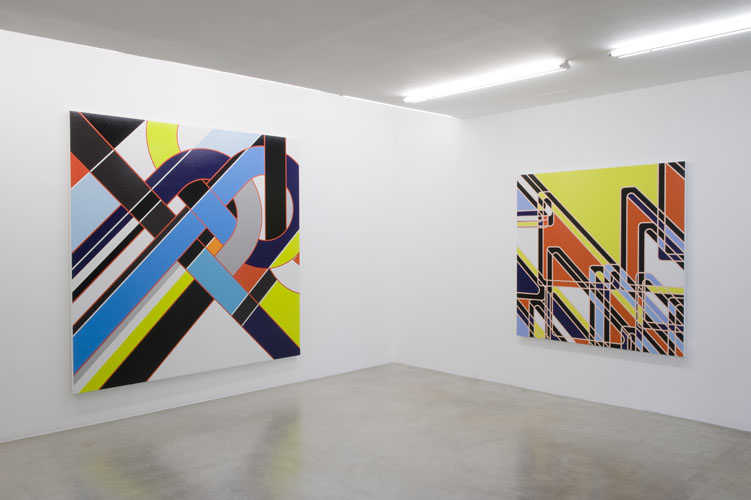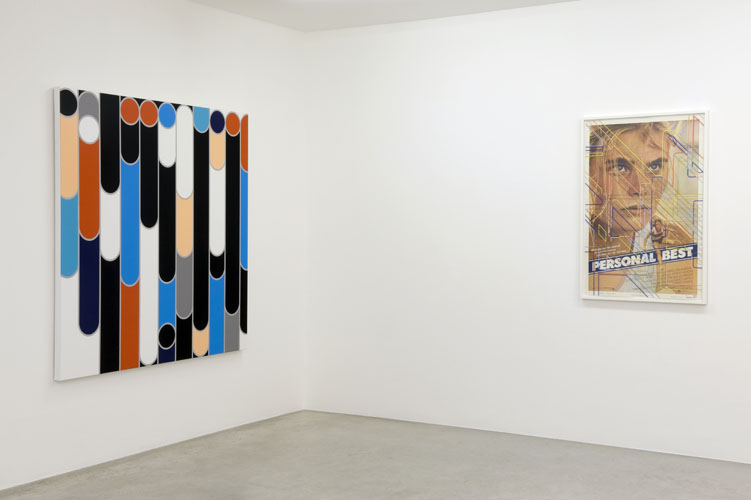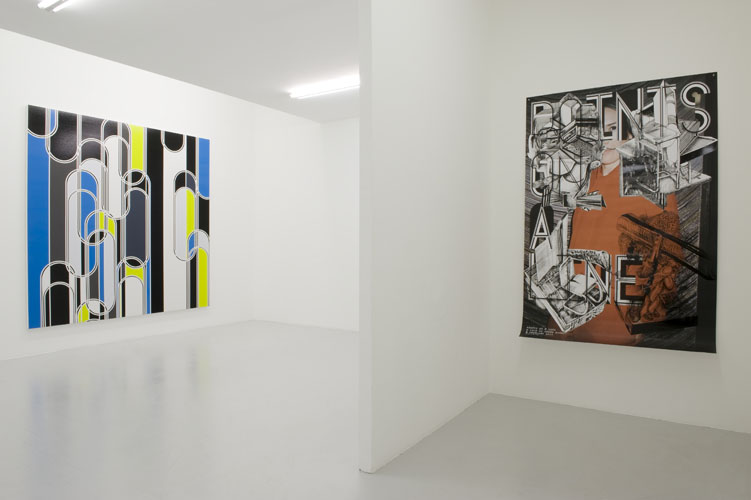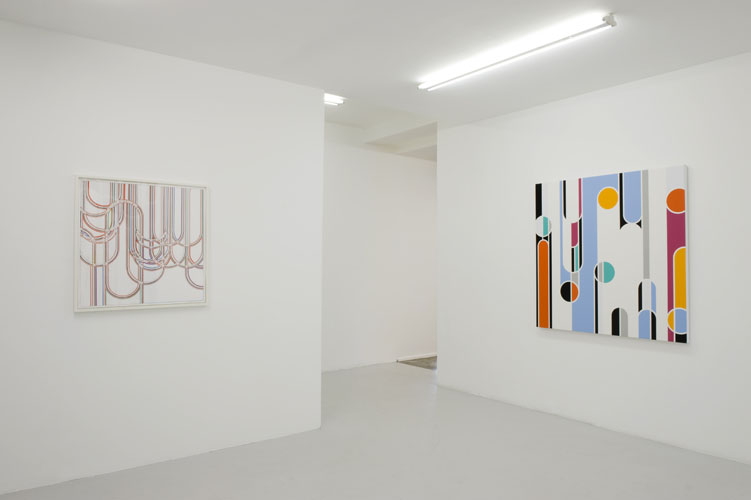

Air de Paris a le plaisir de présenter l’exposition personnelle de Sarah MORRIS, la troisième qu’elle consacre à cette artiste internationalement reconnue. Son titre, Personal Best, reprend celui du film écrit par Robert Towne en 1986 (à qui elle consacra en 2006 un film), et dont l’affiche est devenu support d’un des dessins de l’exposition.
A l’occasion de cette exposition, elle présente des peintures issues de ses dernières séries, nommées Knots and Clips, nœuds et trombones et John Hancock. Dans Knots and Clips, Sarah Morris recourt à d’humbles objets de bureau mais symboles d’âpres opérations mentales : la mise en rapport, la liaison, la réunion. Dénoués de toute fonction, pures formes combinatoires, ils sont ici l’occasion de la génération de motifs complexes. Fond et forme sont indiscernables et les agencements de couleur contribuent à leur complexité, en dépit de la clarté quasi-analytique des tableaux. Ces simples éléments de liaison permettent autant une utilisation pérenne que l’organisation temporaire de textes ou données.
Une peinture de sa dernière série, John Hancock, est également présentée. Son point de départ est l’immeuble –icône bâti en 1967 à Chicago par Skidmore, Owings et Merrill, appelé le centre John Hancock, du nom de la compagnie d’assurance qui y siège, l’un des premiers immeuble multi-fonction (centre commercial, appartements…), et dont elle reprend les formes. La série joue aussi sur l’histoire de John Hancock, dont le nom est synonyme de signature aux Etats-Unis, tant celle qu’il apposa au bas de la déclaration d’indépendance des Etats-Unis était emphatique. Et sur la récupération de son nom par une entreprise. Sarah Morris établit un parallèle entre la récupération du nom Hancock et l’usage qu’elle a dans cette série de ses propres initiales, évoquant une histoire déjà ancienne, non pas seulement celle du design industriel, mais aussi celle du rôle de la signature dans la confirmation de l’autorité et la validation de l’œuvre d’art.
Les peintures de Sarah Morris créent une forme en perpétuels éclatement et auto-génération. Et qui, sans résolution aucune, créent des images d’après le capitalisme et d’avant les nouveaux systèmes de contrôle. L’artiste, tant dans ses peintures que dans ses films, donne lieu à un nouveau niveau de discours, mettant en jeu à la fois une perfection trompeuse, les structures bureaucratiques du contrôle et des réseaux, ainsi que leur tentative de masquer leur propre pouvoir. C’est alors en investiguant sur les manques et effets de raté de leurs usages que l’artiste infiltre ces systèmes de domination et crée des systèmes d’interprétation ambivalents, voire contradictoires.
Dans l’exposition est également projeté le film « Points on a Line » (2010). La Farnsworth House à Plano, Illinois and la Glass House, à New Canaan, dans le Connecticut. Philip Johnson et Mies van der Rohe. Un commissaire d’exposition et un architecte. Un architecte et un architecte. Le film documente un désir commun de construire des structures qui pourraient changer la façon dont nous pensons une maison, une forme et un contexte. Ces deux bâtiments sont le résultat d’idées partagées et de désirs communs. Mais elles complexifient les idées de copie et d’original et la chronologie du modernisme. Scrutant les effets de surface que leur trompeuse transparence mime de leur refuser, Sarah MORRIS transforme l’exercice contemporain fastidieux et convenu de la réévaluation critique de l'histoire du modernisme en une contemplation hypnotique, visuelle et glacée sans aucune acmé. A l'image de la bande sonore, composée par Liam Gillick : un pur flux, des vues très précises sur des points de détail, sans perdre de vue qu'ils forment une ligne, pour reprendre le vocabulaire kandinskien du titre.
En documentant attentivement la maintenance quotidienne de ces deux bâtiments et s’attardant sur l’emplacement précis de ces structures dans l’espace et sur les objets qu’elles contiennent, nous constatons à quel point ces lieux ont dépassé leurs premières et modestes fonctions et sont à l’intersection d’un dialogue à la fois personnel et professionnel. Sarah Morris a filmé les deux sites pendant plusieurs mois, de même que d’autres lieux, ainsi le Four Seasons Restaurants, le Seagram Building, le Lake Shore Drive décrié de Mies van der Rohe, et la Newberry Library de Chicago. Sarah Morris recourt en particulier au Four Seasons comme point de rencontre entre les deux architectes : designé par Philip Johnson (et qui l’utilisait pratiquement comme son bureau privé), il se situe dans le Seagram Building de Mies van der Rohe. Le film est à la fois l’enregistrement de l’état de conservation des deux bâtiments et documente les jeux de pouvoir qui laissèrent une trace dans l’idéalisme pragmatique de la fin du modernisme
Sarah MORRIS vit et travaille à New York et Londres. Elle a reçu le prix de la Joan Mitchell Foundation Painting en 2001, et en 1999–2000 elle fut lauréate du prix de Berlin de l’American Academy Award. Elle a été exposée dans de nombreux pays, avec des expositions personnelles au Museum für (Moderne Kunst, Frankfurt (2009), au Museo d'Arte Moderna, Bologna (2009), à la Fondation Beyeler, Riehen⁄Basel (2008), au Museum Boijmans van Beuningen, Rotterdam (2006), au Moderna Museet, Stockholm (2005), au Palais de Tokyo, Paris 2005), à la Kestner Gesellschaft, Hannover (2005), au Kunstforeningen, Copenhagen (2004), au Miami MOCA (2002), au Hirshhorn Museum, Washington D.C. (2002), et à la Nationalgalerie im Hamburger Bahnhof, Berlin (2001). En 2010 elle réalisait deus œuvres in situ à la Gateway School of Science dans le Queens avec les architectes Pei Cobb Freed and Partners, ainsi qu’une au K20 Kunstsammlung Nordrhein–Westfalen Museum à Düsseldorf, en Allemagne.
////////
Sarah Morris
Personal Best
May 13 - June 25


Air de Paris is delighted to present the new solo exhibition by Sarah MORRIS, the third by this internationally recognised artist at Air de Paris. The exhibition title Personal Best is a reference to the 1986 movie written by Robert Towne, to whom Sarah Morris devoted a film in 2006. She has used the film poster as the support for one of the drawings in the exhibition.
In this exhibition Sarah MORRIS is presenting paintings and drawings from her last series, Knots and Clips and John Hancock. In Knots and Clips she has turned to simple office items and their capacity to symbolise such demanding mental operations as establishing connections, liaising and unifying. Devoid of all function, these purely combinatory forms are used to generate intricate motifs in which – despite the pictures' quasi-analytical clarity – form and content are indistinguishable and the colour orchestration heightens the overall complexity. These simple binding structures suggest a transition from enduring utility to contingent organization or text, data and copied material.
A painting from her very last series John Hancock is also presented. Using as a starting point the iconic 1967 Skidmore, Owings and Merrill building, called the John Hancock Center, Morris uses forms reminiscent of the structure of the first multi-use high rise building in America, named for John Hancock Mutual Life Insurance company, a developer and original tenant of the building. The painting also play with the history of John Hancock as the ‘father of the signature’ and the corporatization of Hancock’s signature for Mutual Life. Morris parallels and streamlines the corporatization of Hancock’s signature using her own initials in the new work, invoking a long history of not only industrial design, but also the role of the signature in relation to its confirmation of ownership, agreement to act and validation of artistic work.
Morris's paintings create a form that is continuously splintering and self-generating, and without resolution, creating after-images of capitalism and pre-images of new systems of control. Morris's project, which spans both painting and film, creates a new level of discourse - playing simultaneously architecture, industrial design, entertainment, commerce and politics. Morris portrays, with beguiling perfection, bureaucratic structures of control and networks and the attempt to mask their own power. The infiltration and use of these mainstream forms and the creation of systems of interpretation that are ambivalent and even possibly contradictory is achieved by engaging and investigating moments of failure toward its use and avoidance.
The exhibition will also feature Morris’s film "Points on a Line" (2010). The Farnsworth House, Plano, Illinois and the Glass House, New Canaan, Connecticut. Philip Johnson and Mies van der Rohe. Curator and architect. Architect and architect. The film documents a shared desire to build structures that might change the way we think about a house, a form and a context. These two buildings were the result of shared ideas and collective desire. But they also complicate ideas of the copy and the original and the chronologies of Modernism. Scrutinising the surface effects their misleading transparency pretends to deny them, Morris turns today's tediously conventional exercises in critical reassessment of the history of modernism into an icily hypnotic visual contemplation free of any apogee. The same is true of Liam Gillick's sound track: pure flux, precise focus on points of detail without losing sight of the line they form, as signalled by the Kandinsky-sounding title.
By carefully documenting the daily maintenance of these two buildings and lingering over the precise placement of the structures in space and of objects within each structure, we are presented with a clear view of places that have gone beyond their initial modest use and become the intersection of a dialogue that was both personal and professional. Morris filmed at both sites over the course of several months, among other locations including The Four Seasons Restaurants, the Seagram Building, Mies van der Rohe's infamous Lake Shore Drive, and Chicago's Newberry Library. Morris utilizes The Four Seasons, a place that Philip Johnson practically used as his personal office, as the meeting point between the two architects. Morris’s film is both a record of preservation of two structures and a document of power plays that left a mark in the pragmatic idealism of the late modern period.
Morris lives and works in New York and London. She received the Joan Mitchell Foundation Painting Award in 2001, and in 1999–2000 was an American Academy Award, Berlin Prize Fellow. She has widely exhibited internationally, with solo exhibitions including the Museum für Moderne Kunst, Frankfurt (2009), Museo d'Arte Moderna, Bologna (2009), Fondation Beyeler, Riehen⁄Basel (2008), the Museum Boijmans van Beuningen, Rotterdam (2006), Moderna Museet, Stockholm (2005), Palais de Tokyo, Paris (2005), Kestner Gesellschaft, Hannover (2005), Kunstforeningen, Copenhagen (2004), Miami MOCA (2002), Hirshhorn Museum, Washington D.C. (2002), and Nationalgalerie im Hamburger Bahnhof, Berlin (2001). She will be realizing two permanent site–specific artworks in 2010 at the Gateway School of Science in Queens with the architectural firm Pei Cobb Freed and Partners and another at K20 Kunstsammlung Nordrhein–Westfalen Museum in Düsseldorf, Germany, which opened on July 9th, 2010.